PREFACE
In this text, we portray the rich diversity of human life across the world and humanize geographic issues by representing the daily lives of women, men, and children in the various regions of the globe. Our goal is to make global patterns of trade and consumption meaningful for students by showing how these patterns affect environments and people at the local level. This third edition of World Regional Geography Concepts strives to reach this goal with improvements to make this text as current, instructive, and visually appealing as possible. At just 481 pages, the text is designed to allow instructors to cover all world regions in a single semester.
NEW TO THE THIRD EDITION
Themes
Teaching world regional geography is never easy. Many instructors have found that focusing their courses on a few key ideas makes their teaching more effective and helps students retain information. With that goal in mind, we have identified five themes that provide a few basic hooks on which students can hang their growing knowledge of the world and each of its regions. These themes are listed here in the order in which they are covered in every chapter:
Environment: How do issues of water scarcity, water pollution, and water management affect people and environments in a particular region? How do food production systems impact environments and societies in a region? What are the indications that climate change is underway? How might global climate change and changes in food production systems affect water resources? How are places, people, and ecosystems in a particular region vulnerable to the shifts that climate change may bring? Which human activities contribute significant amounts of greenhouse gases?
Globalization and Development: How has a particular region been impacted by globalization, historically and currently? How are lives changing as flows of people, ideas, products, and resources become more global? How do shifts in economic, social, and other dimensions of development affect human well-
being? What paths have been charted by the so- called developed world, and how are they relevant, or irrelevant, to the rest of the world? What new “homegrown” solutions are emerging from the so- called less developed countries? Power and Politics: What are the main differences in the ways that power is wielded in societies? Where are authoritarian modes of governance dominant? Where have political freedoms expanded the most? What kind of changes is the expansion of political freedoms bringing to different world regions? How are changes in the geopolitical order affecting current world events?
Urbanization: Which forces are driving urbanization in a particular region? How have cities responded to growth? How are regions affected by the changes that accompany urbanization—
for example, the growth of slums and changes in access to jobs, education, and health care? Population and Gender: What are the major forces driving population growth or decline in a region? How have changes in gender roles influenced population growth or decline? How are changes in life expectancy, family size, and the age of the population influencing population change?
Geographic Insights
For each chapter, the five themes form the basis of five learning objectives that we call Geographic Insights. These insights are stated at the beginning of each chapter and discussed at the relevant point in the text. To improve consistency, the Geographic Insights are now completely comparable across chapters. Geographic Insights are reviewed in “Things to Remember” sections found throughout the chapter, as well as in new questions posed in the “Geographic Insights Review and Self-
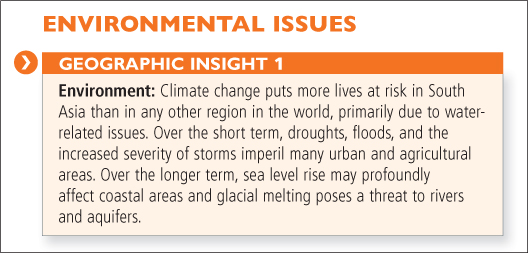
Restructured Chapters
Each chapter has been restructured so that the discussions to which the Geographic Insights refer now occur in the same order in each chapter. We implemented this change to make it easier for teachers and students to navigate the complex topics of world regional geography. The number of themes has also been condensed, from nine in the previous edition to five in this edition. Discussions of climate change, food, and water now come under the heading of “Environmental Issues.” Globalization and development are now discussed in one section. The theme of “democratization” has been broadened to include geopolitics and other political issues and is now called “Power and Politics.” Some discussions of population issues have been linked with discussions of gender.
On the Bright Side
In light of the often overwhelming and at times depressing nature of the information presented in any world regional geography course, each chapter now has a series of new On the Bright Side commentaries that explore some of the more hopeful patterns and opportunities emerging within each region.
Local Lives Photo Feature
Three Local Lives photo features in each region chapter add further human interest by showing regional customs related to foodways, people and animals, and festivals. Each photo has an extensive caption designed to pique students’ curiosity.
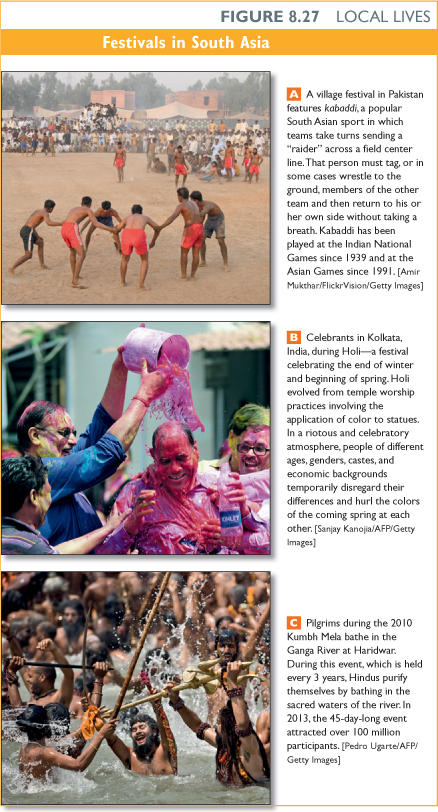
New Photos
Every photo has been updated for currency in this edition. An ongoing aim of this text has been to awaken students to the circumstances of people around the world, and photos are a powerful way to accomplish this objective. This edition continues our tradition of promoting careful attention to photos by including in Chapter 1 a short lesson on photo interpretation. Students are encouraged to use these skills as they look at every photo in the text, and instructors are encouraged to use the photos as lecture themes and to help generate analytical class discussions.

Each photo was chosen to complement a concept or situation described in the text. All photos are numbered and referenced in the text, making it easier for students to integrate the text with the visuals as they read. Moreover, the photos—
At the beginning of each regional chapter, a series of photos surrounding the regional map introduces the reader to landscapes within the region. Subsequent figures that are Photo Essays illustrate particular themes. For example, each region has a photo essay about urbanization, including a map of national urbanization rates and large cities as well as photos that illustrate various aspects of urban life in the region.
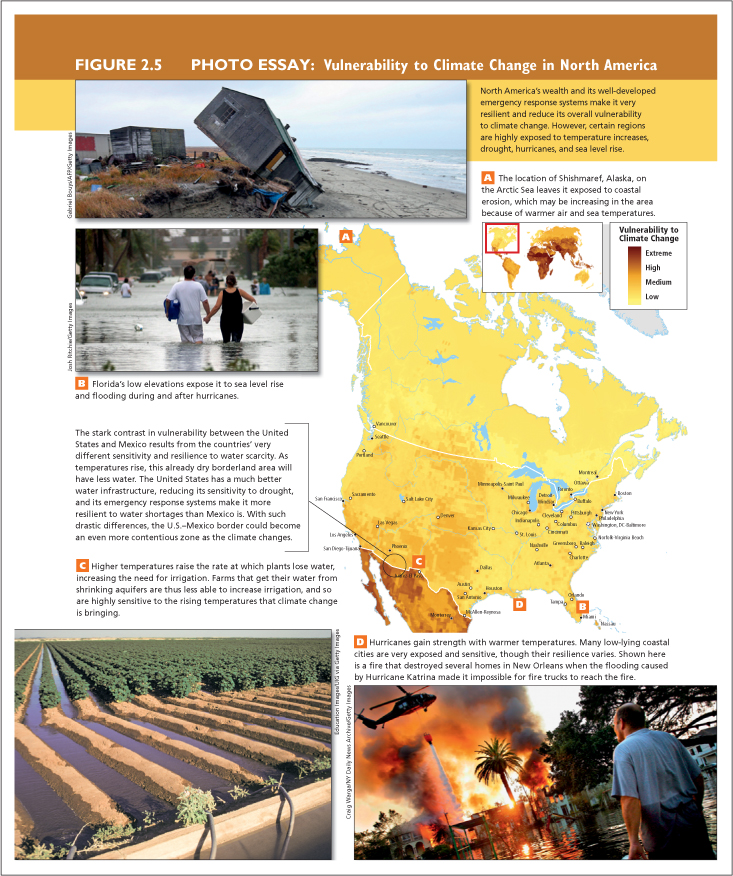
To help instructors make use of all these new photo features in their teaching, the many photo essays and photo figures are accompanied by Thinking Geographically questions. The questions are found at the end of each chapter, and the answers can be found on this book’s Web site, where they form the basis of computer-
Up-to-Date Content
Because the world is constantly changing, it is essential that a world regional geography text be as current as possible. Some major content areas of the book that have been updated include:
Climate change and its environmental, political, and economic implications
Page xvThe global economic recession that began in 2008 and its effect on migrants, labor outsourcing, and job security in importing and exporting countries
The role of terrorism in the realignment of power globally and locally
The growing disparity in wealth in North America
Domestic and global implications of the U.S. political, economic, and military stances
Conflict over oil pollution in the Amazon
Immigration and the ways it is changing countries economically and culturally
Changing gender roles, particularly in developing countries
Recent economic crises in the European Union and the consequences for the original EU members, new and potential member states, and the global community
Growing tensions between Russia, its neighbors, the European Union, and the United States
Political revolutions and conflict (the Arab Spring) in North Africa and Southwest Asia (often referred to as the Middle East)
The new influence of Arabic media outlets, such as Al Jazeera
Maps reflecting the new country of South Sudan (some data remain based on Sudan as a whole because South Sudan has not yet begun reporting statistics)
Growing tensions over water in South Asia
Disputes in East Asia over the Senkaku Islands
Civil unrest in Thailand
The consequences of global climate change on Pacific Island nations
Consistent Base Maps
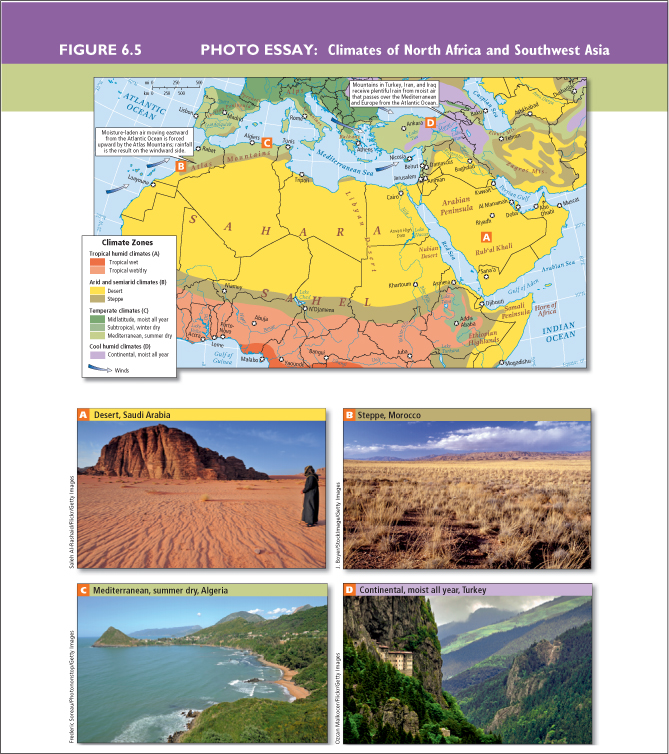
This edition focuses on improving further what has often been cited as a principal strength of this text: high-
Regional map with landscape photos at the beginning of each chapter
Political map
Climate map with photos of different climate zones
Map of the human impacts on the biosphere, with photo essay
Map of the region’s vulnerability to climate change, with photo essay
Map of regional trends in power and politics, with photo essay
Urbanization map, with photo essay
Map of population density
Videos
More than 400 videos clips (an average of about 35 per chapter) are available with the third edition. Most videos are 2 to 6 minutes long and cover key issues discussed in the text. They can help instructors gain further expertise or can be used to generate class discussion. Each video is keyed to the text with an icon at the point in the discussion where it is most relevant. These videos, along with a related multiple-
Visual Histories
These visual timelines for each region use images to illustrate key points in the region’s history.
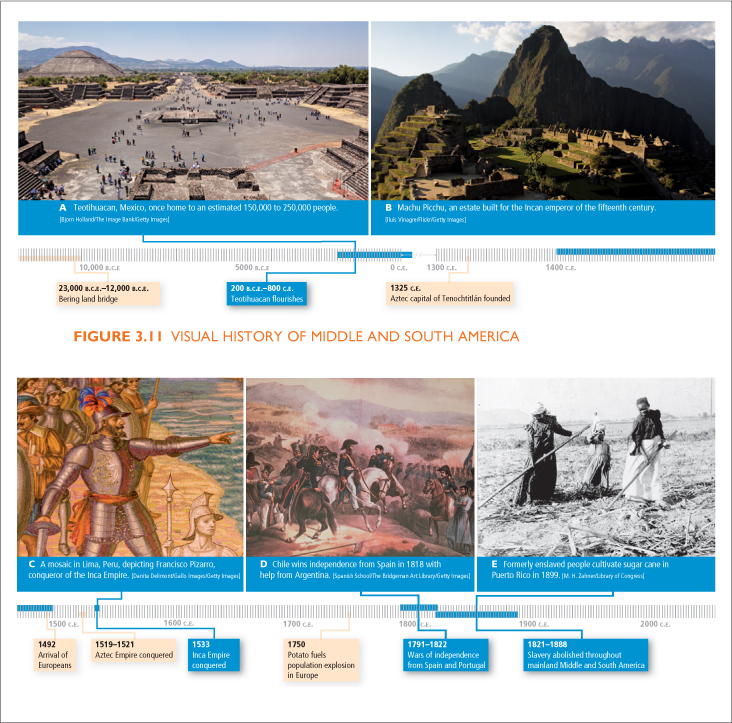
Things to Remember
At the close of every main section, a few concise statements review the important points in the section. The statements emphasize some key themes while encouraging students to think through the ways in which the material illustrates these points. They also review the Geographic Insights that begin each chapter.
Geographic Insights Review and Self-Test
At the end of each chapter, a series of questions, many tied to the chapter’s Geographic Insights, encourage students to more broadly analyze the chapter content. These questions could be used for assignments, group projects, or class discussion.
Marginal Glossary of Key Terms
Terms important to the chapter content are boldfaced on first usage and defined on the page on which they first appear. Each term is listed at the end of the chapter, along with the number of the page where the term is defined. The key terms are also listed alphabetically and defined in the glossary at the end of the book.
THE ENDURING VISION: GLOBAL AND LOCAL PERSPECTIVES
The Global View
In addition to the new features and enhancements to the text, we retain the hallmark features that have made the first two editions of this text successful for instructors and students. For the third edition, we continue to emphasize global trends and the connections between regions that are changing lives throughout the world. The following linkages are explored in every chapter, as appropriate:
The multifaceted economic linkages among world regions. These include (1) the effects of colonialism; (2) trade; (3) the role in the world economy of transnational corporations such as Walmart, Norilsk Nickel, Nike, and Apple; (4) the influence of regional trade organizations such as ASEAN and NAFTA; and (5) the changing roles of the World Bank and the International Monetary Fund as the negative consequences of structural adjustment programs become better understood. These issues are explored primarily in the Globalization and Development section of each chapter.
Migration. Migrants are changing economic and social relationships in virtually every part of the globe. The societies they leave are changed radically by the migrants’ absence, just as the host societies are altered by their presence. The text explores the local and global effects of foreign workers in places such as Japan, Europe, Africa, the Americas, and Southwest Asia, as well as the increasing number of refugees resulting from conflicts around the world. Also discussed are long-
standing migrant groups, including the Overseas Chinese and the Indian diasporas. These topics are explored primarily in Population and Gender as well as the Sociocultural Issues sections of each chapter. Gender issues are covered in every chapter with the aim of addressing more completely the lives of ordinary people. Gender is intimately connected to other patterns, including internal and global migration, and these connections and other region-
wide gender patterns are illustrated in a variety of maps and photos and in vignettes that illustrate gender roles as played out in the lives of individuals. The lives of children, especially with regard to their roles in families, are also covered, often in concert with the treatment of gender issues. These issues are explored primarily in Population and Gender as well as the Sociocultural Issues sections of each chapter.
The Local Level
We pay special attention in this book to the local scale—
Local lives: We use photo essays to focus on particular regional customs and traditions as they relate to foodways, festivals, and the relationship of animals to the people of a region.
Cultural change: We look closely at changes in the family, gender roles, and social organization in response to urbanization, modernization, and the global economy.
Impacts on well-
being: Ideas of what constitutes “well-being” differ from culture to culture, yet broadly speaking, people everywhere try to provide a healthful life for themselves in a community of their choosing. Their success in doing so is affected by local conditions, global forces, and their own ingenuity. Issues of identity: Paradoxically, as the world becomes more tightly knit through global communications and media, ethnic and regional identities often become stronger. The text examines how modern developments such as the Internet and related technologies are used to reinforce particular cultural identities, often bringing educated emigrants back to help with reforms or to facilitate rapid responses in crises.
Local attitudes toward globalization: People often have ambivalent reactions to global forces: they are repelled by the seeming power of these forces, fearing effects on their own lives and livelihoods and on local traditional cultural values, but they are also attracted by the economic opportunities that may emerge from greater global integration. The text looks at how the people of a region react to cultural and economic globalization.
ALSO AVAILABLE
To better serve the different needs of diverse faculty and curricula, two other versions of this textbook are available.
World Regional Geography (with Subregions), Sixth Edition (1-
The sixth edition continues to employ a consistent structure for each chapter. Each chapter beyond the first is divided into three parts: The Geographic Setting, Current Geographic Issues, and Subregions.
The subregion coverage provides a descriptive characterization of particular countries and places within the region that expands on coverage in the main part of the chapter. For example, the sub-
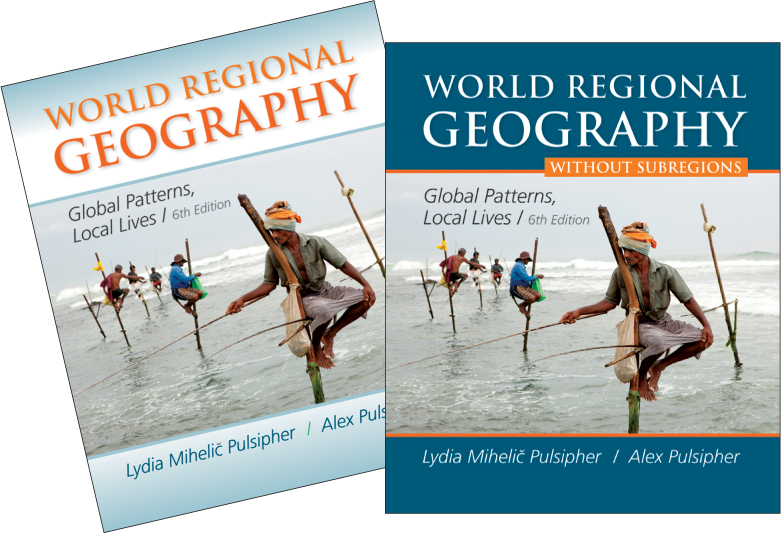
World Regional Geography Without Subregions, Sixth Edition (1-
The briefer version provides essentially the same main text coverage as the version described above, omitting only the subregional sections. This version contains all the pedagogy found in the main version.
FOR THE INSTRUCTOR: A WEALTH OF RESOURCES ONLINE AT GEOGRAPHY LAUNCHPAD

The authors have taught world regional geography many times and understand the need for quick, accessible aids to instruction. Many of the new features were designed to streamline the job of organizing the content of each class session, with the goal of increasing student involvement through interactive discussions. Ease of instruction and active student involvement were the principal motivations behind the book’s key features—
All of the following are available on Geography LaunchPad, a complete course management system that features full gradebook and reporting capacities. For a demo of Geography LaunchPad, please contact your W. H. Freeman/Macmillan Education sales consultant.
All text images in PowerPoint and JPEG formats with enlarged labels for better projection quality.
PowerPoint lecture outlines by Nicole C. James. The main themes of each chapter are outlined and enhanced with images from the book, providing a pedagogically sound foundation on which to build personalized lecture presentations.
Instructor’s Resource Manual by Jennifer Rogalsky, State University of New York, Geneseo, and Helen Ruth Aspaas, Virginia Commonwealth University, contains suggested lecture outlines, points to ponder for class discussion, and ideas for exercises and class projects. It is offered as chapter-
by- chapter Word files to facilitate editing and printing. Test Bank by Rebecca Johns, University of South Florida, expanded from the original test bank created by Jason Dittmer, University College London, and Andy Walter, West Georgia University. The Test Bank is designed to match the pedagogical intent of the text and offers more than 2500 test questions (multiple choice, short answer, matching, true/false, and essay) in a Word format that makes it easy to edit, add, and resequence questions. A computerized test bank (powered by Diploma) with the same content is also available.
Clicker questions by Rebecca Johns, University of South Florida. Prepared in Word, clicker questions allow instructors to jump-
start discussions, illuminate important points, and promote better conceptual understanding during lectures. An integrated gradebook that records students’ performance on online and video quizzes.
Course Management
All instructor and student resources are also available via BlackBoard, Canvas, Angel, Moodle, Sakai, and Desire2Learn. W. H. Freeman offers a course cartridge that populates your site with content tied directly to the book. For access to a specific course cartridge, please contact your W. H. Freeman/Macmillan Education sales consultant.
W. H. Freeman World Regional Geography DVD
This DVD, available free to adopters of the third edition, gives students and instructors access to the fascinating personal stories of people from all over the world, building on the book’s purpose of putting a face on geography. The DVD contains 35 projection-
FOR THE STUDENT: WORLD REGIONAL GEOGRAPHY ONLINE WITH GEOGRAPHY LAUNCHPAD

A wealth of resources to support the textbook are available online on Geography LaunchPad:
Chapter quizzes: These multiple-
choice quizzes help students assess their mastery of each chapter. Thinking Geographically questions: These questions relate to select photos found throughout the book. The question sets form the basis of computer-
graded exercises that can be assigned and automatically graded and entered into the instructor’s online gradebook. Thinking Critically About Geography: These activities allow students to explore a set of current issues, such as deforestation, human rights, or free trade, and see how geography helps clarify our understanding of them. Linked Web sites are matched with a series of questions or with brief activities that help students think about the ways in which they themselves are connected to the places and people they read about in the text.
Blank outline maps: Printable maps of the world and of each region are available for note taking, exam review, or both, as well as for preparing assigned exercises.
Flashcards: Matching exercises teach vocabulary and definitions.
Audio pronunciation guide: This spoken guide helps students learn to pronounce place names, regional terms, and names of historical figures.
World recipes and cuisines: From International Home Cooking, the United Nations International School cookbook, these recipes provide students with the opportunity to explore foods from around the world.
Geography LaunchPad also offers users a set of unique resources not available anywhere else:
Map Builder software and Map Builder exercises: The Map Builder program allows students to create layered thematic maps on their own, while Map Builder exercises offer a specific activity for each chapter in the third edition.
Map learning exercises: Students can use these interactive activities to identify and locate countries, cities, and the major geographic features of each region. Instructors can assign these map exercises as homework or as quizzes; student results report directly to the instructor’s online gradebook.
An e-
Book of World Regional Geography Concepts, complete and customizable. Students can quickly search the text and personalize it just as they would the printed version—complete with highlighting, bookmarking, and note- taking features. A Guide to Using Google Earth for the novice, plus step-
by- step Google Earth exercises for each chapter. Selected articles from Focus on Geography magazine (one for each chapter in the textbook) and accompanying quizzes for each article.
Physical geography videos for instructors who want to cover physical geography topics in more detail.
Online news feeds for highly respected magazines such as the Economist.
An online atlas prepared specifically for World Regional Geography Concepts.

Learning Curve is an integral part of Geography LaunchPad. It is an intuitive, fun, and highly effective formative assessment tool that is based on extensive educational research. Students can use Learning Curve to test their knowledge in a low-
Also Available: Rand McNally’s Atlas of World Geography, 176 pages
This atlas, available at a greatly reduced price when bundled with the textbook, contains:
Fifty-
two physical, political, and thematic maps of the world and continents; 49 regional, physical, political, and thematic maps; and dozens of metro- area inset maps Geographic facts and comparisons, covering topics such as population, climate, and weather
A section on common geographic questions, a glossary of terms, and a comprehensive 25-
page index